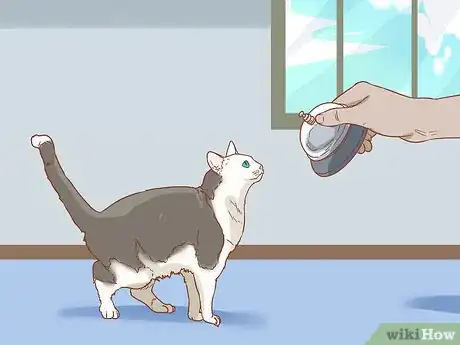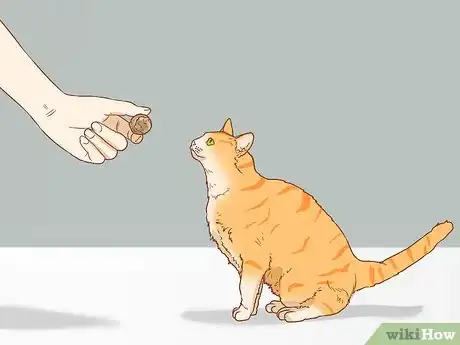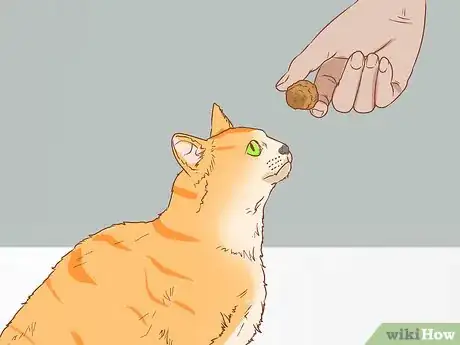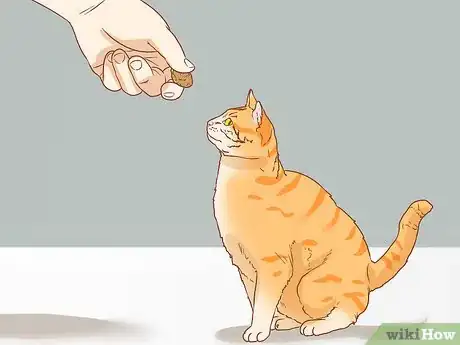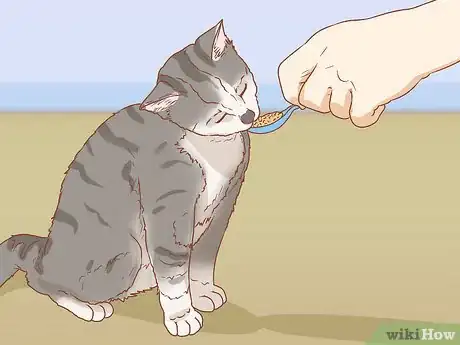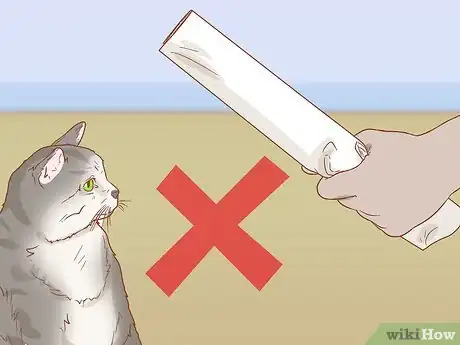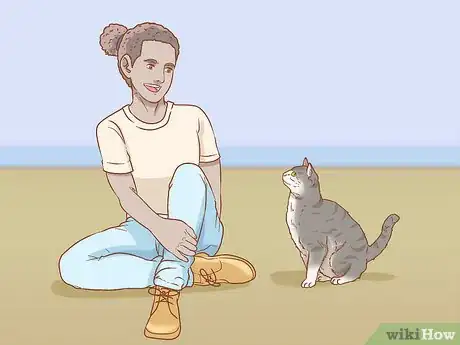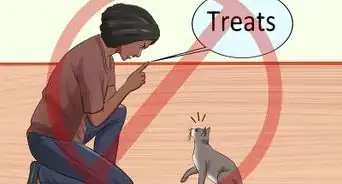This article was co-authored by Brian Bourquin, DVM. Brian Bourquin, better known as “Dr. B” to his clients, is a Veterinarian and the Owner of Boston Veterinary Clinic, a pet health care and veterinary clinic with three locations, South End/Bay Village, the Seaport, and Brookline, Massachusetts. Boston Veterinary Clinic specializes in primary veterinary care, including wellness and preventative care, sick and emergency care, soft-tissue surgery, dentistry. The clinic also provides specialty services in behavior, nutrition, and alternative pain management therapies using acupuncture, and therapeutic laser treatments. Boston Veterinary Clinic is an AAHA (American Animal Hospital Association) accredited hospital and Boston’s first Fear Free Certified Clinic. Brian has over 19 years of veterinary experience and earned his Doctor of Veterinary Medicine from Cornell University.
This article has been viewed 59,054 times.
Training a cat is not necessarily the same as training a dog. While dogs were bred to help, cats were bred to independently keep the house clear of vermin. If you want to teach your feline companion to do different tricks, you’ll have to approach it delicately. Studies have proven that communicating with your cat exercises their brain and makes them happier. You may have heard from people that cats can't be trained, but they can be!
Steps
Using Sounds
-
1Get a clicker. Using a clicker involves reinforcing positive behavior with a sound. When the cat does something you approve of, like squatting towards a sitting position, reward the cat and hit the clicker. Try to avoid rewarding the cat without the clicker noise so there is no confusion about why a reward is happening.[1]
-
2Use vocal cues. Begin the process by making a specific, repeatable sound before feeding the cat. Preferably, this sound can be before opening a can of cat food. Once the cat associates that sound with food, the sound can be used for specific training without food. When you see your cat start to move towards a sit, make the vocal cue. If the cat sits, make the same sound.
- A great way to use this vocal training is to simply get your cat to come to you. After the cat has made a solid association, initiate the training in small steps.[4]
- Don’t allow your cat to jump for the treat. The same vocal cue strategies used to reinforce positive actions can be used to tell your cat that the treat isn’t permitted without sitting down.
Advertisement -
3Give your cat a bell to ring. Try putting a bell at your cat’s eye level and showing it a treat. When the cat wants something and starts to meow, ignore it. When the bell is rung, however, look for the cat to sit and reward it immediately. [5]
- Ignore destructive behavior. Wait for the desired reaction (e.g. squatting towards a sit or actually sitting).
Rewarding with Treats
-
1Remove distractions from a comfortable room in which the cat likes to relax and sit. Cats are easily distracted and you wouldn’t want anything to contradict or interfere with the training. Try to remove sounds, toys, food, and anything else your cat may be tempted by.
- Be sure to choose a room in which your cat is comfortable and used to.
- Close blinds and/or curtains to keep exterior distractions to a minimum.
-
2Break out the good treats. Cats won’t necessarily react to normal treats. They want treats that are soft food, like fish, chicken, or turkey. Use something they love and rarely get.[6]
- Some cats will not be motivated by treats, as cats are not as food-motivated as dogs.[7] You may be able to successfully train your cat without treats. Sometimes a favorite toy works just as well.
-
3
-
4Raise the treat above the cat’s head.[10] Slowly lift the treat in front of the cat’s head, ensuring it's out of reach. The angle of the treat will be such that the cat has to look upward, and the cat's anatomy is beneficially angled. This should cause the cat to sit down.
-
5Reward often and consistently. The ASPCA recommends training your cat twice a day, for five minutes each.[11] The training could be just the squatting motion, or the raising of the cat's head, as long as the movement is a precursor to sitting. Aim to have your cat repeat the action 20 times in each training session.
- Practicing too much could be counter-productive.[12]
- Be sure to reinforce the training on subsequent days until the cat gets it.
Avoiding Negative Reinforcement
-
1Motivate with treats over praise. Motivating a cat isn’t likely with praise. They don’t work in a partnership, so there is no reason to really do what you command. [13] When the cat sits, you can praise it, but be sure to do so with a treat as well.
-
2Be positive. Cats do not respond well to dominance or stress.[14] When stressed, they are likely act out, and they certainly won’t be responsive to training. [15] To avoid negative reactions from your cat, be sure not to react negatively to failure or setbacks.[16] When your cat doesn't sit immediately, and it won't, remember the following:
- Do not punish.[17] There is a good chance that no matter the punishment, your cat won't make an association between it and the action. If it doesn't sit and you punish it, there may be an association with any number of other things instead of your actual command.[18]
- Do not get physical with the cat. Hitting, shaking, or slapping could make it fearful. If that happens, the cat may avoid you, which will make training nearly impossible.
- Do not force the issue. The more you force it, the more likely the cat will stress out. Cats learn on their own terms, and at different speeds. You may just frighten the cat if you push too hard.
- Use the treats solely for training. If you use the treats too often, your cat will start to beg. It will pester you for a treat when it does anything whatsoever.
-
3Sit on the ground. You will want to be on the ground with your cat to show you want its attention. It may also help because being higher than your cat could appear like you’re about to pounce and show dominance. The extra focus should help when trying to persuade your cat to start the sitting movements.
Expert Q&A
Did you know you can get expert answers for this article?
Unlock expert answers by supporting wikiHow
-
QuestionCan I train my cat to sit?
 Pippa Elliott, MRCVSDr. Elliott, BVMS, MRCVS is a veterinarian with over 30 years of experience in veterinary surgery and companion animal practice. She graduated from the University of Glasgow in 1987 with a degree in veterinary medicine and surgery. She has worked at the same animal clinic in her hometown for over 20 years.
Pippa Elliott, MRCVSDr. Elliott, BVMS, MRCVS is a veterinarian with over 30 years of experience in veterinary surgery and companion animal practice. She graduated from the University of Glasgow in 1987 with a degree in veterinary medicine and surgery. She has worked at the same animal clinic in her hometown for over 20 years.
Veterinarian
-
QuestionHow do you train a cat to come when called?
 Pippa Elliott, MRCVSDr. Elliott, BVMS, MRCVS is a veterinarian with over 30 years of experience in veterinary surgery and companion animal practice. She graduated from the University of Glasgow in 1987 with a degree in veterinary medicine and surgery. She has worked at the same animal clinic in her hometown for over 20 years.
Pippa Elliott, MRCVSDr. Elliott, BVMS, MRCVS is a veterinarian with over 30 years of experience in veterinary surgery and companion animal practice. She graduated from the University of Glasgow in 1987 with a degree in veterinary medicine and surgery. She has worked at the same animal clinic in her hometown for over 20 years.
Veterinarian
-
QuestionCan cats be taught commands?
 Pippa Elliott, MRCVSDr. Elliott, BVMS, MRCVS is a veterinarian with over 30 years of experience in veterinary surgery and companion animal practice. She graduated from the University of Glasgow in 1987 with a degree in veterinary medicine and surgery. She has worked at the same animal clinic in her hometown for over 20 years.
Pippa Elliott, MRCVSDr. Elliott, BVMS, MRCVS is a veterinarian with over 30 years of experience in veterinary surgery and companion animal practice. She graduated from the University of Glasgow in 1987 with a degree in veterinary medicine and surgery. She has worked at the same animal clinic in her hometown for over 20 years.
Veterinarian
Warnings
- Cats do throw up when they eat too much, so don’t go overboard with treats.⧼thumbs_response⧽
- If cat does get sick or begins to vomit, immediately call a vet.⧼thumbs_response⧽
References
- ↑ http://www.rd.com/advice/pets/how-to-train-a-cat/
- ↑ https://www.petfinder.com/cats/cat-behavior-and-training/how-to-teach-a-cat-tricks/
- ↑ http://www.rd.com/advice/pets/how-to-train-a-cat/
- ↑ http://www.rd.com/advice/pets/how-to-train-a-cat/
- ↑ http://www.purina.com.au/cats/training/train
- ↑ https://www.petfinder.com/cats/cat-behavior-and-training/how-to-teach-a-cat-tricks/
- ↑ Brian Bourquin, DVM. Cat Behavior Trainer. Expert Interview. 20 December 2019.
- ↑ http://www.purina.com.au/cats/training/train
- ↑ https://www.petfinder.com/cats/cat-behavior-and-training/how-to-teach-a-cat-tricks/
- ↑ http://www.rd.com/advice/pets/how-to-train-a-cat/
- ↑ http://www.rd.com/advice/pets/how-to-train-a-cat/
- ↑ https://www.petfinder.com/cats/cat-behavior-and-training/how-to-teach-a-cat-tricks/
- ↑ https://www.petfinder.com/cats/cat-behavior-and-training/how-to-teach-a-cat-tricks/
- ↑ Brian Bourquin, DVM. Cat Behavior Trainer. Expert Interview. 20 December 2019.
- ↑ https://www.petfinder.com/cats/cat-behavior-and-training/how-to-teach-a-cat-tricks/
- ↑ http://www.rd.com/advice/pets/how-to-train-a-cat/
- ↑ Brian Bourquin, DVM. Cat Behavior Trainer. Expert Interview. 20 December 2019.
- ↑ http://www.humanesociety.org/animals/cats/tips/training_your_cat_positive_reinforcement.html
About This Article
To teach your cat to sit, hold a treat, such as fish or chicken, above its head, which will make your cat look up and sit down. Then, give your cat a treat each time it sits. Try to train your cat in this way twice a day for 5 minutes. Alternatively, click a ballpoint pen every time your cat sits or moves towards a sitting position, and reward it with a treat. Once your cat learns to associate the clicking sound with the treat and sitting down, you should be able to make it sit simply by clicking the pen. For tips on how to avoid stressing out your cat during a training session, keep reading!


